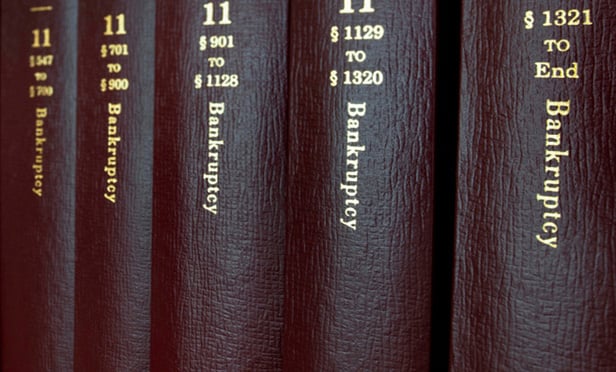Features

Update on Bankruptcy Appellate Practice Part Four: Interlocutory Appeals — Deadlines
This installment of our appellate series reviews recent cases addressing the district courts' review of interlocutory bankruptcy court orders and the enforceability of appellate deadlines. As we have shown with other case law governing appeals, real obstacles confront practitioners appealing from bankruptcy court rulings.
Features

Corporate Resiliency Revisited: Ensure Financial Health Ahead of an Economic Downturn
now is a critical time for companies to reassess their business and finances if they have not already, so that they can be prepared for the future. Proper planning is key to ensuring a company's financial health when facing an economic downturn.
Features

Poorly Drafted Nondisclosure Agreements Can Have Lasting, and Expensive, Results
In today's increasingly complex, competitive and litigious business environment where nondisclosure agreements have crept in scope to also be noncompete agreements or anti-poaching agreements in addition to confidentiality agreements, the need for legal professionals with generalized knowledge who have managed business enterprises on a whole has become a mainstay of the corporate world.
Features

Update on Bankruptcy Appellate Practice Part Three — Finality
This installment of our appellate practice series reviews recent cases addressing the appellate jurisdiction of district courts and the courts of appeals, referred to as the "finality" doctrine.
Features

Bankruptcy Court Gives Pre-Petition Antitrust Claims Administrative Priority Status
The Delaware District Bankruptcy Court ruled that claims arising from pre-petition antitrust cases filed against the debtor could constitute post-petition claims entitled to administrative priority status. The court held that the public policy that favors a "fresh start" for debtors would not preclude damages from post-petition sales of products in violation of federal antitrust laws from receiving administrative expense priority.
Features

Will Supreme Court Settle Sale of Tax Liens Issue?
There's a split among circuit courts on whether tax foreclosure sales may be avoidable as preferential and fraudulent transfers by property owners who subsequently seek relief under the Bankruptcy Code. If the Supreme Court eventually weighs in to resolve this circuit split, property owners, municipalities, and potential bidders for tax liens across the country will receive greater clarity on this critical issue.
Features

Bankruptcy Practices Using Slowdown to Restructure, Sniff Out Distressed Sectors
Bankruptcy practice leaders admittedly have some time on their hands, which they're using to sniff out insolvency in distressed sectors and market their services to existing and potential clients.
Features

Update on Bankruptcy Appellate Practice: Part Two — Equitable Mootness
This installment of our appellate practice series reviews recent cases addressing the equitable mootness doctrine. The issue ultimately often turns on whether it is practical and fair for an appellate court to review an appeal on the merits, enabling that court to avoid review altogether.
Features

Chapter 15 Can Impact Foreign Bankruptcy As Well As Domestic Civil Litigation
At first glance, Chapter 15 might appear to have the relatively minor role of staying actions against U.S. assets while the main foreign proceeding moves forward. However, as one recent case out of the Southern District of New York demonstrates, Chapter 15 carries the potential to significantly impact not only the main foreign bankruptcy, but civil litigation in the United States as well.
Features

Using Section 365(n) to Minimize Loss of Use of IP In Licensor Bankruptcy
This article provides an overview of Section 365 of the Bankruptcy Code, a key provision within the Code that allows a debtor to assume, assume and assign, or reject certain executory contracts and unexpired leases.
Need Help?
- Prefer an IP authenticated environment? Request a transition or call 800-756-8993.
- Need other assistance? email Customer Service or call 1-877-256-2472.
MOST POPULAR STORIES
- The DOJ's New Parameters for Evaluating Corporate Compliance ProgramsThe parameters set forth in the DOJ's memorandum have implications not only for the government's evaluation of compliance programs in the context of criminal charging decisions, but also for how defense counsel structure their conference-room advocacy seeking declinations or lesser sanctions in both criminal and civil investigations.Read More ›
- The DOJ's Corporate Enforcement Policy: One Year LaterThe DOJ's Criminal Division issued three declinations since the issuance of the revised CEP a year ago. Review of these cases gives insight into DOJ's implementation of the new policy in practice.Read More ›
- Use of Deferred Prosecution Agreements In White Collar InvestigationsThis article discusses the practical and policy reasons for the use of DPAs and NPAs in white-collar criminal investigations, and considers the NDAA's new reporting provision and its relationship with other efforts to enhance transparency in DOJ decision-making.Read More ›
- Don't Sleep On Prohibitions on the Assignability of LeasesAttorneys advising commercial tenants on commercial lease documents should not sleep on prohibitions or other limitations on their client's rights to assign or transfer their interests in the leasehold estate. Assignment and transfer provisions are just as important as the base rent or any default clauses, especially in the era where tenants are searching for increased flexibility to maneuver in the hybrid working environment where the future of in-person use of real estate remains unclear.Read More ›
- Developments in Distressed LendingRecently, in two separate cases, secured lenders have received, as part of their adequate protection package, the right to obtain principal paydowns during a bankruptcy case.Read More ›
